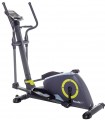Flywheel location
The location of the flywheel relative to the pedals of the cross trainer. Most often it is installed at the
rear, but there are also
models with front location. The differences between both options are very small, so in fact, only the appearance of the cross trainer depends on the location of the flywheel.
Flywheel weight
The weight of the flywheel installed in the cross trainer. It is a massive wheel, the rotation of which ensures the movement of the pedals and creates a load on them. It is believed that the more weight, the better: a massive flywheel provides smooth movement with a minimum of jerks and creates uniform loads that mimic natural ones as much as possible. This is especially important for athletes with a large body weight — from 100 kg and above. At the same time, it should be taken into account that the cost of the entire cross trainer directly depends on the weight of the flywheel, and for home non-professional use it is not always justified to look for a machine with a very heavy flywheel.
Load levels
The number of fixed load levels (pedal resistance during movement) provided for in the design of the cross trainer. The more such levels provided in the design, the wider the possibilities for adjusting the load and the more accurately it can be adjusted to the requirements of a particular user. At the same time, the abundance of adjustments accordingly affects the price.
Q factor
Q factor — the distance between the cross trainer pedals. Anatomically correct running position for ankles suggests a Q factor between 50mm and 90mm. The exact value depends on the height and build of a particular user. Cross trainer with a Q factor up to 90 mm allows you to remove excess stress from the joints of the legs. Of course, it must be taken into account that with the growth of the Q factor, the load on the user's muscular system automatically increases. So, models with an indicator above 90 mm allow for more effective training. But at the same time, an anatomically incorrect position of the legs is assumed, which can adversely affect the health of the joints. If the user has any diseases associated with the joints, you should choose a cross trainer with an optimal Q factor for your height and build (from 50 to 90 mm).
Step length
The maximum horizontal distance between the pedals of the cross trainer, determines, respectively, the length of the athlete's step when working on the machine. It is believed that for people of average height, a step length of 400 – 500 mm is optimal, and many cross trainers are made with this calculation. At the same time, there are models with a variable step length, which allows you to adjust it to the personal preferences of different users.
Anyway, the step length should be chosen depending on height, physique and personal preferences. Too small a step will lead to the fact that you have to mince, and the imitation of walking will turn into marking time, and too wide will lead to inconvenience and an unjustified increase in load without increasing efficiency. Ideally, it is advisable to test the cross trainer before buying — how comfortable you will be on it. This applies to both fixed and adjustable step lengths.
Foldable design
The ability
of folding the cross trainer to reduce its dimensions during storage and transportation. This feature saves space — the machine can be unfolded to full size and collapsed after use — which is especially true for small apartments where there is little floor space. At the same time, foldable designs are somewhat less reliable than classic ones. Therefore, it is worth looking specifically for such a machine only if compactness is of decisive importance to you.
Training programs
The number of
training programs provided for in the design of the cross trainer. Different programs have different purposes — strengthening the cardiovascular system, maintaining physical fitness, burning fat, etc. At the same time, the operation of the program relieves you of the need to manually set the parameters — this is done by the machine. Accordingly, the more training programs the cross trainer has, the wider its capabilities and the more convenient the training. And some models may even provide the possibility of custom programs.
Dimensions
The dimensions of the equipment in the assembled and ready-to-work state. It is important to note that more space is needed for the comfortable and proper operation of the machine.

